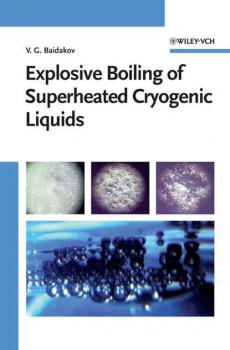Прочая образовательная литература
Различные книги в жанре Прочая образовательная литератураExplosive Boiling of Superheated Cryogenic Liquids
The monograph is devoted to the description of the kinetics of spontaneous boiling of superheated liquefied gases and their solutions. Experimental results are given on the temperature of accessible superheating, the limits of tensile strength of liquids due to processes of cavitation and the rates of nucleation of classical and quantum liquids. The kinetics of evolution of the gas phase is studied in detail for solutions of cryogenic liquids and gas-saturated fluids. The properties of the critical clusters (bubbles of critical sizes) of the newly evolving gas phase are analyzed for initial states near the equilibrium coexistence curves of liquid and gas, for states near the limits of accessible superheating and for initial states near the respective spinodal curves. Finally, processes of explosive boiling of cryogenic liquids are considered occurring as the result of outflow processes and intensive interactions with high-temperature liquid samples.
A User's Guide to Vacuum Technology
In the decade and a half since the publication of the Second Edition of A User?s Guide to Vacuum Technology there have been many important advances in the field, including spinning rotor gauges, dry mechanical pumps, magnetically levitated turbo pumps, and ultraclean system designs. These, along with improved cleaning and assembly techniques have made contamination-free manufacturing a reality. Designed to bridge the gap in both knowledge and training between designers and end users of vacuum equipment, the Third Edition offers a practical perspective on today?s vacuum technology. With a focus on the operation, understanding, and selection of equipment for industrial processes used in semiconductor, optics, packaging, and related coating technologies, A User?s Guide to Vacuum Technology, Third Edition provides a detailed treatment of this important field. While emphasizing the fundamentals and touching on significant topics not adequately covered elsewhere, the text avoids topics not relevant to the typical user.
A Group-Theoretical Approach to Quantum Optics
Written by major contributors to the field who are well known within the community, this is the first comprehensive summary of the many results generated by this approach to quantum optics to date. As such, the book analyses selected topics of quantum optics, focusing on atom-field interactions from a group-theoretical perspective, while discussing the principal quantum optics models using algebraic language. The overall result is a clear demonstration of the advantages of applying algebraic methods to quantum optics problems, illustrated by a number of end-of-chapter problems. An invaluable source for atomic physicists, graduates and students in physics.
Optics and Spectroscopy at Surfaces and Interfaces
This book covers linear and nonlinear optics as well as optical spectroscopy at solid surfaces and at interfaces between a solid and a liquid or gas. The authors give a concise introduction to the physics of surfaces and interfaces. They discuss in detail physical properties of solid surfaces and of their interfaces to liquids and gases and provide the theoretical background for understanding various optical techniques. The major part of the book is dedicated to a broad review on optical techniques and topical applications such as infrared and optical spectroscopy or optical microscopy. Discussions of nonlinear optics, but also nano-optics and local spectroscopy complement this self-contained work. Helpful features include about 50 problems with solutions, a glossary and a thoroughly elaborated list of topical references. The book is suited as a text for graduate students but also for scientists working in physics, chemistry, materials or life sciences who look for an expert introduction to surface optical aspects of their studies.
The Molecular Basis of Cellular Defence Mechanisms
The field of lymphokine research has grown in parallel to the exciting developments around the two sets of cells which defend the body. While lymphokines are the «property» of immunologists, the molecular regulators of hemopoiesis (CSFs) belong to the hematologists. This book offers the rare opportunity to examine these separate fields of expertise together.
Advances in Enzymology and Related Areas of Molecular Biology, Part B
The Advances in Enzymology and Related Areas of Molecular Biology Series is one of the most prestigious in the field, devoted to the latest trends in molecular biology and enzymology. Each volume of the series contains contributions from leading authorities in the field. Under Dr. Purich's editorship, which began with volume 72, the series has expanded its coverage to include thematic volumes focusing on specific research areas, as well as non-thematic volumes consisting of chapters with a more general appeal.
Advances in Enzymology and Related Areas of Molecular Biology, Part A
This book is Part A in a subseries entitled «Amino Acid Metabolism». Topics in Part A should be of immediate interest to those who are broadly concerned with amino acid assimilation and metabolism. Investigators interested in enzyme mechanism and regulation will also find this volume especially valuable.
Advances in Enzymology and Related Areas of Molecular Biology, Part A
Biological catalysis plays a dominant role both in fermentation and industrial process chemistry. This collection of chapters, written by a well-known biochemist and enzymologist, should serve as an invaluable reference to those investigators seeking to optimize the application of enzymatic catalysis for commercial purposes.
Advances in Enzymology and Related Areas of Molecular Biology
Enzymes are used frequently in modifying proteins for specialized uses. These books cover the latest advances in this field and its applications in the field of molecular biology. General overview of the latest developments in the field of molecular biology. This is latest volume in the successful Wiley series on enzymology as applied to molecular biology.
Advances in Enzymology and Related Areas of Molecular Biology
Advances in Enzymology and Related Areas of Molecular Biology is a seminal series in the field of biochemistry, offering researchers access to authoritative reviews of the latest discoveries in all areas of enzymology and molecular biology. These landmark volumes date back to 1941, providing an unrivaled view of the historical development of enzymology. The series offers researchers the latest understanding of enzymes, their mechanisms, reactions and evolution, roles in complex biological process, and their application in both the laboratory and industry. Each volume in the series features contributions by leading pioneers and investigators in the field from around the world. All articles are carefully edited to ensure thoroughness, quality, and readability. With its wide range of topics and long historical pedigree, Advances in Enzymology and Related Areas of Molecular Biology can be used not only by students and researchers in molecular biology, biochemistry, and enzymology, but also by any scientist interested in the discovery of an enzyme, its properties, and its applications.









